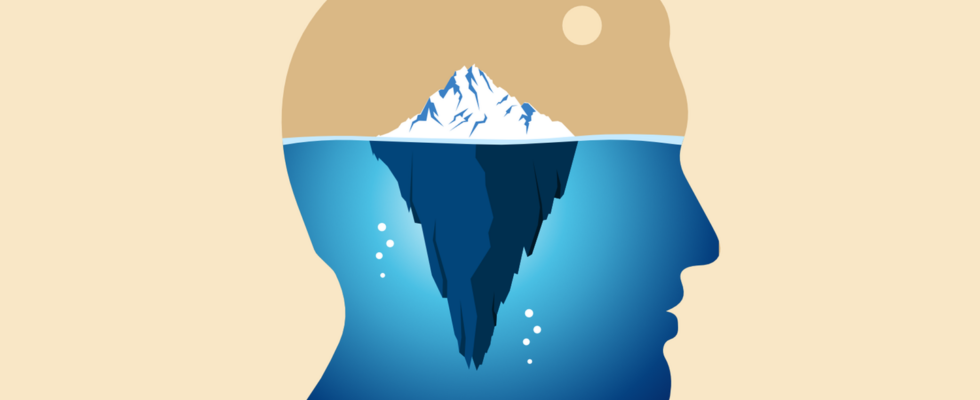Not everything we feel is real. Our iceberg is to blame for some of this. Our author tries to explain what this is all about and how we make it waver.
We have known how an iceberg works since Titanic at the latest. What sticks out at the top is only a very small part. The much larger one lies beneath the surface of the water and is not visible. This is exactly how our consciousness works. And because it likes to play tricks on us from time to time, it’s good to know our mechanisms and patterns and put them to the test. Because what we feel doesn’t always correspond to reality.
What is behind the iceberg principle?
The iceberg model goes back to Sigmund Freud. He assumed that our actions in daily situations are only consciously determined to a small extent. He therefore divided the psyche into three entities: the ego, in which our conscious parts lie, the id, in which our feelings are anchored, and the superego, which represents our moral authority and our conscience. Of these three instances, the id and the superego take place in our subconscious, while we are conscious of the much smaller part – the ego. The whole thing is made clear by the iceberg model. Only a small part of our personality is visible; the much larger part, which influences our thoughts and actions, lies beneath the surface of the water, hidden in the unconscious. And while the id and the superego are in constant battle with each other, it is the ego’s job to play the referee between the two. If a conflict arises, a compromise must be negotiated, which in turn shows itself in a symptom, depending on how we are shaped.
What does this mean for our actions?
Most of our actions occur unconsciously. Our actions are based on the subconscious, i.e. on all the experiences we have had in our lives so far. In addition to positive experiences, there are also fears, repressed conflicts, curiosity, our idea of security and insecurity, trust and distrust, desire satisfaction and beliefs – all of these feelings guide us. This can also be problematic. In some cases, our feelings don’t have much to do with reality, but are based on assumptions that have been stored in our iceberg since early childhood and that still trigger unpleasant feelings even though we have long since outgrown them. From today’s perspective we might evaluate them completely differently, but they are deeply rooted in our iceberg. This in turn has a major influence on how we conduct relationships and evaluate ourselves. If we don’t bring them to the surface of our consciousness and process them there, they may influence us for the rest of our lives without us being able to consciously explain it.
What our iceberg wants to tell us
Psychological processes always go through a kind of evaluation that is carried out by the ego. But if our ego is currently in a real crisis (breakups, death of a loved one, job loss, change of residence…), our iceberg, with all its learned fears, makes us believe that we have feelings that do not correspond to reality. And then he likes to reproduce icy beliefs like “I can’t do this,” “Nothing will ever be okay again,” “I’ll always be alone.” or “I’m not good enough.”. This in turn makes us feel terribly bad. The reality check proves exactly the opposite.
An example: A phobia of spiders.
Purely rationally, we all know that the creepy crawlies can’t harm us (we’re assuming normal, non-poisonous house spiders), but some people are still very afraid of them because they may have had a traumatic experience in childhood. But if you look more closely and approach your fear little by little, it can be overcome. In reality, no one has ever died from coming into contact with a house spider. And this is how most of our fears, beliefs and assumptions work. Except that they have an even more far-reaching impact in other areas. And then it just takes time to prove yourself wrong.
When our iceberg principle becomes a problem
Our iceberg principle can cause great difficulties whenever changes are imminent or we are interacting with others. Especially in crises, it stirs up fears that, objectively speaking, have not yet occurred, but still bother us so much that they can even lead to panic attacks and depression. The unconscious part of the iceberg triggers feelings in us that, upon closer inspection, have nothing to do with the current situation. But even in relationships, assumptions about our iceberg often cloud our view because they mean we can never really be objective and misunderstandings and arguments arise because we talk past each other.
How are we now shaking at the bottom of the iceberg?
The iceberg is quite a chunk. After all, we have been carrying him around with us since we were children. Once he’s been shaken, he doesn’t like the fact that something is about to happen that will throw him off his feet. But it takes time until we recognize our patterns and reverse them. After all, our brains are no longer as quick to learn. The unconscious part of our iceberg will always get in our way. But the more we practice attributing the feelings and seeing whether this is just our iceberg principle telling us our old beliefs or whether the assumption is actually correct, the better we can break out of our patterns. What helps is to look very closely and continually question our assumptions and patterns, reflect and be kind to ourselves. For very difficult mountains, coaching or therapy can also help.
